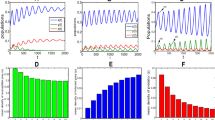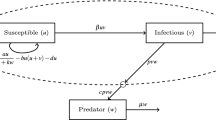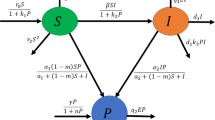Abstract
In this article, we have presented an infected predator-prey model with Holling type II functional response where the predator population is divided into two sub-classes, namely susceptible and infected due to disease. Here, we have assumed that the fear induced by susceptible and infected predators are of different levels. Well-posedness of the model system along with persistence criterion and the conditions of local stability of each equilibrium point have been established. Direction of Hopf bifurcation near the interior equilibrium point has been investigated. From model analysis, it is observed that fear induced by both susceptible and infected predators jointly determine dynamical complexity of the system. Fear induced by susceptible predators enhances the stable coexistence of the system whereas high amount of fear induced by infected predators destabilizes the system. It is also observed that the ratio of the birth rate of prey and the level of fear induced by both the susceptible and infected predators actively determine the topological behaviour of the system. We have performed comprehensive and meticulous numerical simulations to verify and validate the analytical findings of our model system, and finally, the article is ended up with a conclusion.










Similar content being viewed by others
References
Anderson RM, May RM (1979) Population biology of infectious diseases: part i. Nature 280(5721):361
Anderson RM, May RM (1981) The population dynamics of microparasites and their invertebrate hosts. Philos Trans R Soc Lond B Biol Sci 291(1054):451–524
Barlow N (2000) Non-linear transmission and simple models for bovine tuberculosis. J Anim Ecol 69(4):703–713
Barman D, Roy J, Alam S (2020) Trade-off between fear level induced by predator and infection rate among prey species. J Appl Math Comput 64:635–663
Belvisi S, Venturino E (2013) An ecoepidemic model with diseased predators and prey group defense. Simul Model Pract Theory 34:144–155
Bera S, Maiti A, Samanta G (2015) Modelling herd behavior of prey: analysis of a prey-predator model. World J Model Simul 11(1):3–14
Capasso V, Serio G (1978) A generalization of the Kermack–McKendrick deterministic epidemic model. Math Biosci 42(1–2):43–61
Chakraborty K, Jana S, Kar T (2012) Global dynamics and bifurcation in a stage structured prey-predator fishery model with harvesting. Appl Math Comput 218(18):9271–9290
Chattopadhyay J, Arino O (1999) A predator-prey model with disease in the prey. Nonlinear Anal 36(6):747–766
Chattopadhyay J, Pal S, Abdllaoui AE (2003) Classical predator-prey system with infection of prey population—a mathematical model. Math Methods Appl Sci 26(14):1211–1222
Chen F, Chen L, Xie X (2009) On a Leslie-Gower predator-prey model incorporating a prey refuge. Nonlinear Anal Real World Appl 10(5):2905–2908
Clinchy M, Sheriff MJ, Zanette LY (2013) Predator-induced stress and the ecology of fear. Funct Ecol 27(1):56–65
Creel S, Christianson D (2008) Relationships between direct predation and risk effects. Trends Ecol Evol 23(4):194–201
Creel S, Christianson D, Liley S, Winnie JA (2007) Predation risk affects reproductive physiology and demography of elk. Science 315(5814):960–960
Cresswell W (2011) Predation in bird populations. J Ornithol 152(1):251–263
Das A, Samanta G (2018) Modeling the fear effect on a stochastic prey-predator system with additional food for the predator. J Phys A Math Theor 51(46):465601
Diekmann O, Kretzschmar M (1991) Patterns in the effects of infectious diseases on population growth. J Math Biol 29(6):539–570
Gao X, Pan Q, He M, Kang Y (2013) A predator-prey model with diseases in both prey and predator. Physica A 392(23):5898–5906
Haque M, Venturino E (2007) An ecoepidemiological model with disease in predator: the ratio-dependent case. Math Methods Appl Sci 30(14):1791–1809
Hassard BD, Hassard B, Kazarinoff ND, Wan YH, Wan YW (1981) Theory and applications of Hopf bifurcation, vol. 41. CUP Archive
Holling CS (1965) The functional response of predators to prey density and its role in mimicry and population regulation. Mem Entomol Soc Can 97(S45):5–60
Kant S, Kumar V (2017) Stability analysis of predator-prey system with migrating prey and disease infection in both species. Appl Math Model 42:509–539
Kermack WO, McKendrick AG (1927) A contribution to the mathematical theory of epidemics. Proc R Soc Lond Ser A Containing Pap Math Phys Charact 115(772):700–721
Khajanchi S (2017) Modeling the dynamics of stage-structure predator-prey system with monod-haldane type response function. Appl Math Comput 302:122–143
Khan Q, Balakrishnan E, Wake G (2004) Analysis of a predator-prey system with predator switching. Bull Math Biol 66(1):109–123
Kooi BW, Venturino E (2016) Ecoepidemic predator-prey model with feeding satiation, prey herd behavior and abandoned infected prey. Math Biosci 274:58–72
Kot M (2001) Elements of mathematical ecology. Cambridge University Press, Cambridge
Li J, Gao W (2010) Analysis of a prey-predator model with disease in prey. Appl Math Comput 217(8):4024–4035
Lima SL (1998) Nonlethal effects in the ecology of predator-prey interactions. Bioscience 48(1):25–34
Lima SL (2009) Predators and the breeding bird: behavioral and reproductive flexibility under the risk of predation. Biol Rev 84(3):485–513
Liu M, Jin Z, Haque M (2009) An impulsive predator-prey model with communicable disease in the prey species only. Nonlinear Anal Real World Appl 10(5):3098–3111
Liu S, Beretta E (2006) A stage-structured predator-prey model of Beddington-Deangelis type. SIAM J Appl Math 66(4):1101–1129
Wm Liu, Hethcote HW, Levin SA (1987) Dynamical behavior of epidemiological models with nonlinear incidence rates. J Math Biol 25(4):359–380
Wm Liu, Levin SA, Iwasa Y (1986) Influence of nonlinear incidence rates upon the behavior of sirs epidemiological models. J Math Biol 23(2):187–204
Lotka A (1925) Elements of physical biology. Williams and Wilkins, Baltimore
Lu Y, Li D, Liu S (2016) Modeling of hunting strategies of the predators in susceptible and infected prey. Appl Math Comput 284:268–285
May RM, Anderson RM (1979) Population biology of infectious diseases: part ii. Nature 280(5722):455
May RM, Anderson RM (1987) Commentary transmission dynamics of HIV infection. Nature 326:137
Mbava W, Mugisha J, Gonsalves JW (2017) Prey, predator and super-predator model with disease in the super-predator. Appl Math Comput 297:92–114
Mondal A, Pal A, Samanta G (2019) On the dynamics of evolutionary leslie-gower predator-prey eco-epidemiological model with disease in predator. Ecol Genet Genomics 10:100034
Murray J (1993) Mathematical biology. Springer, New York
Olsson M, Pauliny A, Wapstra E, Blomqvist D (2010) Proximate determinants of telomere length in sand lizards (Lacerta agilis). Biol Lett 6(5):651–653
Pada Das K et al (2011) A mathematical study of a predator-prey dynamics with disease in predator. ISRN Appl Math 2011
Pal S, Majhi S, Mandal S, Pal N (2019) Role of fear in a predator-prey model with Beddington-Deangelis functional response. Zeitschrift für Naturforschung A 74(7):581–595
Pal S, Pal N, Samanta S, Chattopadhyay J (2019) Effect of hunting cooperation and fear in a predator-prey model. Ecol Complex 39:100770
Panday P, Pal N, Samanta S, Chattopadhyay J (2018) Stability and bifurcation analysis of a three-species food chain model with fear. Int J Bifurc Chaos 28(01):1850009
Panday P, Pal N, Samanta S, Chattopadhyay J (2019) A three species food chain model with fear induced trophic cascade. Int J Appl Comput Math 5(4):100
Peacor SD, Peckarsky BL, Trussell GC, Vonesh JR (2013) Costs of predator-induced phenotypic plasticity: a graphical model for predicting the contribution of nonconsumptive and consumptive effects of predators on prey. Oecologia 171(1):1–10
Pettorelli N, Coulson T, Durant SM, Gaillard JM (2011) Predation, individual variability and vertebrate population dynamics. Oecologia 167(2):305
Pielou E (1977) Mathematical ecology. Wiley, New York
Preisser EL, Bolnick DI (2008) The many faces of fear: comparing the pathways and impacts of nonconsumptive predator effects on prey populations. PLoS ONE 3(6):e2465
Roberts M (1996) The dynamics of bovine tuberculosis in possum populations, and its eradication or control by culling or vaccination. J Anim Ecol 451–464
Roy J, Alam S (2020) Fear factor in a prey-predator system in deterministic and stochastic environment. Physica A 541:123359
Roy J, Barman D, Alam S (2020) Role of fear in a predator-prey system with ratio-dependent functional response in deterministic and stochastic environment. Biosystems 104176
Sahoo B, Poria S (2014) Diseased prey predator model with general holling type interactions. Appl Math Comput 226:83–100
Sasmal SK (2018) Population dynamics with multiple allee effects induced by fear factors-a mathematical study on prey-predator interactions. Appl Math Model 64:1–14
Sha A, Samanta S, Martcheva M, Chattopadhyay J (2019) Backward bifurcation, oscillations and chaos in an eco-epidemiological model with fear effect. J Biol Dyn 13(1):301–327
Sheriff MJ, Krebs CJ, Boonstra R (2009) The sensitive hare: sublethal effects of predator stress on reproduction in snowshoe hares. J Anim Ecol 78(6):1249–1258
Svennungsen TO, Holen ØH, Leimar O (2011) Inducible defenses: continuous reaction norms or threshold traits? Am Nat 178(3):397–410
Travers M, Clinchy M, Zanette L, Boonstra R, Williams TD (2010) Indirect predator effects on clutch size and the cost of egg production. Ecol Lett 13(8):980–988
Venturino E (1994) The influence of disease on Lotka-Volterra system. Rocky Mt J Math
Volterra V (1926) Fluctuations in the abundance of a species considered mathematically
Wang X, Zanette L, Zou X (2016) Modelling the fear effect in predator-prey interactions. J Math Biol 73(5):1179–1204
Wang X, Zou X (2017) Modeling the fear effect in predator-prey interactions with adaptive avoidance of predators. Bull Math Biol 79(6):1325–1359
Wörz-Busekros A (1978) Global stability in ecological systems with continuous time delay. SIAM J Appl Math 35(1):123–134
Xiao D, Ruan S (2007) Global analysis of an epidemic model with nonmonotone incidence rate. Math Biosci 208(2):419–429
Xiao Y, Chen L (2001) Modeling and analysis of a predator-prey model with disease in the prey. Math Biosci 171(1):59–82
Yorke JA, London WP (1973) Recurrent outbreaks of measles, chickenpox and mumps: Ii. Systematic differences in contact rates and stochastic effects. Am J Epidemiol 98(6):469–482
Zanette LY, White AF, Allen MC, Clinchy M (2011) Perceived predation risk reduces the number of offspring songbirds produce per year. Science 334(6061):1398–1401
Author information
Authors and Affiliations
Corresponding author
Appendix
Appendix
\(A_1\): The detailed calculation of Permanence of Sect. 3.3 The supremum value \(Q_1,Q_2,Q_3\), according to Standard Comparison theorem, can be obtained as a positive solutions of the following system of equations
Solving the above system of equations, we get \(x=\frac{b_1d_2}{c_3}=Q_1,~ y=\frac{c_3d_3-c_4d_2}{ac_3}=Q_2,~ z=\frac{b_1(c_3+d_2)(r-d_1)}{c_2c_3}=Q_3.\) Interestingly, inequalities (3.4), (3.5), (3.6) can be written in the following form
Similarly, we get \(x=\frac{s_1}{s_2}=q_1, y=\frac{d_3\{c_2c_3+bb_1(c_3+d_2)(r-d_1)\}}{ac_2c_3}=q_2, ~z=\frac{c_3^2s_1-b_1d_2s_2(c_3+d_2)}{b_1s_2(c_3+d_2)}=q_3,\) and \(s_1=a^2c_2c_3^2b_1r-\{ac_2c_3+k_1c_2(c_3d_3-c_4d_2)+ab_1k_2(c_3+d_2)(r-d_1)\}\{ab_1c_3d_1+c_1(c_3d_3-c_4d_2)+ab_1(c_3+d_2)(r-d_1)\}\), \(s_2=mab_1c_3\{ac_2c_3+k_1c_2(c_3d_3-c_4d_2)+ab_1k_2(c_3+d_2)(r-d_1)\}\). Now, \(Q_1\) is always positive, \(Q_2>0 ~\mathrm {if}~ c_3d_3>c_4d_2\), \(Q_3, q_2>0\) as \(r>d_1\) and \(q_3\) will be positive if \(\frac{s_1}{s_2}>\frac{b_1d_2(c_3+d_2)}{c_3^2}\) which consequently satisfies the positivity of \(q_1\).
\(A_2\):The detailed calculation of direction and stability of Hopf bifurcation of Sect. 5.2
To find the value of \(\omega _{11}\) and \(\omega _{20}\), we have to solve,
Additionally,
where \(u_1=p_{12}p_{23}-p_{13}p_{22},~u_2=p_{21}p_{13}-p_{11}p_{23},~u_3=p_{11}p_{22}-p_{12}p_{21},~u_4=p_{12}p_{23}-p_{13}p_{23},~u_5=p_{23}-p_{21},~u_6=p_{13}-p_{11},~u_7=p_{22}-p_{21}.\) Now, let us consider \(g_1=1+k_1y^*+k_2z^*,~g_2=b_1+x^*,~g_3=1+bz^*,~g_4=k_1p_{21}+k_2p_{31},~g_5=k_1p_{22}+k_2p_{32},~g_6=k_1p_{23}+k_2p_{33}\) so that \({Q_1}_{x_1 x_1}=\frac{2rg_4(g_4x^*-g_1p_{11})}{g_1^3}-2mp_{11}^2+\frac{2p_{11}p_{21}c_1(x^*-g_2)}{g_2^2}+\frac{2b_1p_{11}^2c_1y^*}{g_2^3}\). Similarly, the other expressions related with the terms \(g_{11},~g_{02},~g_{20},~G_{21},~\omega ,~h_{11},~h_{20},~M_5,~G_{110},~G_{101},~g_{21}\) can be obtained from the partial derivative of \(Q_i,~i=1,2,3\) w.r.t. \(x_1,y_1,z_1\) at the interior equilibrium point \(E^*(x^*,y^*,z^*)\) (for details see Hassard et al. 1981; Khajanchi 2017)
Rights and permissions
About this article
Cite this article
Barman, D., Roy, J. & Alam, S. Dynamical Behaviour of an Infected Predator-Prey Model with Fear Effect. Iran J Sci Technol Trans Sci 45, 309–325 (2021). https://doi.org/10.1007/s40995-020-01014-y
Received:
Accepted:
Published:
Issue Date:
DOI: https://doi.org/10.1007/s40995-020-01014-y




